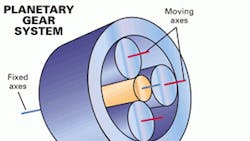Planetary systems are now the gear system of choice for automation applications using servomotors.
Why? Two frequent misconceptions are that planetary systems have low backlash (one to seven arc-min.) and that the low backlash is the main characteristic and requirement for a servo gearbox. The fact is, fixed-axis spur systems can be designed and built just as easily for low backlash. Furthermore, low backlash is not an absolute requirement for servo-based automation applications. A moderate-low backlash — less than 30 arc-min. — is advisable (especially in applications with very high start/stop, forward/reverse cycles) to avoid internal shock loads in the gear mesh. That said, with today's high-resolution motor-feedback devices and associated motion controllers it's easy to compensate for backlash anytime there's a change in the rotation sense or torque-load direction.
So what are the main reasons for selecting expensive, seemingly more-complex planetary systems?
Q&A
Q: Do planetaries offer unique benefits?
A: One important requirement for automation is high torque capability in a compact and light envelope. In other words, high torque density (a high torque/volume or torque/weight ratio) is important for automation applications with changing high dynamic loads to avoid additional system inertia and becoming large and bulky.
Depending upon number of planets, planetary systems distribute transferred torque in multiple gear meshes. This means a planetary gear with three planets can transfer three times the torque of a similarly sized fixed-axis spur gear system.
Q: But how stiff are planetary gears?
A: High rotational stiffness (in other words, minimal elastic windup) is important for applications with positioning accuracy and repeatability requirements, especially under fluctuating loads. The multiple gear meshes of planetary systems mean load is supported by N contacts (where N = number of planet gears) increasing the stiffness by factor N for the minimum of lost motion.
Q: How fast can planetary systems go?
A: Gearboxes must operate at high input speeds; 3,000 rpm for servomotors is almost standard. What's more, servomotors speeds increasing speeds in excess of 10,000 rpm are not uncommon. With increased speed, power density increases proportionally without any real size increase of the motor or electronic drive.
Fixed-axis spur gears can starve on lubrication and quickly fail if running at high speeds, because the lubricant is slung away. Only special means such as expensive pressurized forced lubrication can solve this problem. Grease lubrication is impracticable because of a tunneling effect, wherein grease cannot flow back into the mesh … so running gears create a kind of tunnel in the grease.
In planetary systems the lubricant cannot escape — it is continuously redistributed or ‘pulled’ into the gear contacts, ensuring safe lubrication in practically any mounting position. Even grease lubrication is suitable.
Note: Sometimes fixed-axis gearing systems are erroneously called spur gears, though spurs are actually gears with zero helix angle. Here we compare fixed-axis gearing — spur or otherwise — with planetary systems.
These handy tips provided by Gerhard Antony, Ph.D. of Neugart USA LP, in Bethel Park. Pa. For more information, call (412) 835-4154.
More bang for the buck
For the same gear ratio and volume, the planetary set has three times the torque density and stiffness.
About the Author
Elisabeth Eitel
Elisabeth Eitel was a Senior Editor at Machine Design magazine until 2014. She has a B.S. in Mechanical Engineering from Fenn College at Cleveland State University.
